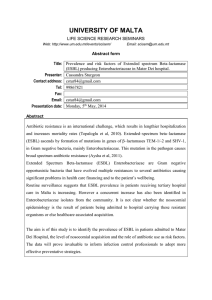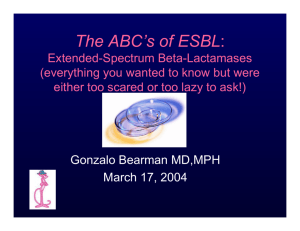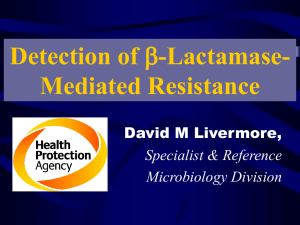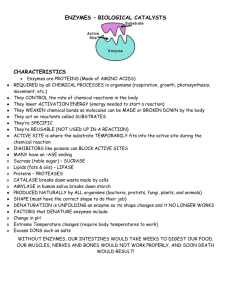CHARACTERIZATION OF CTX-M-TyPE EXTENDED
advertisement
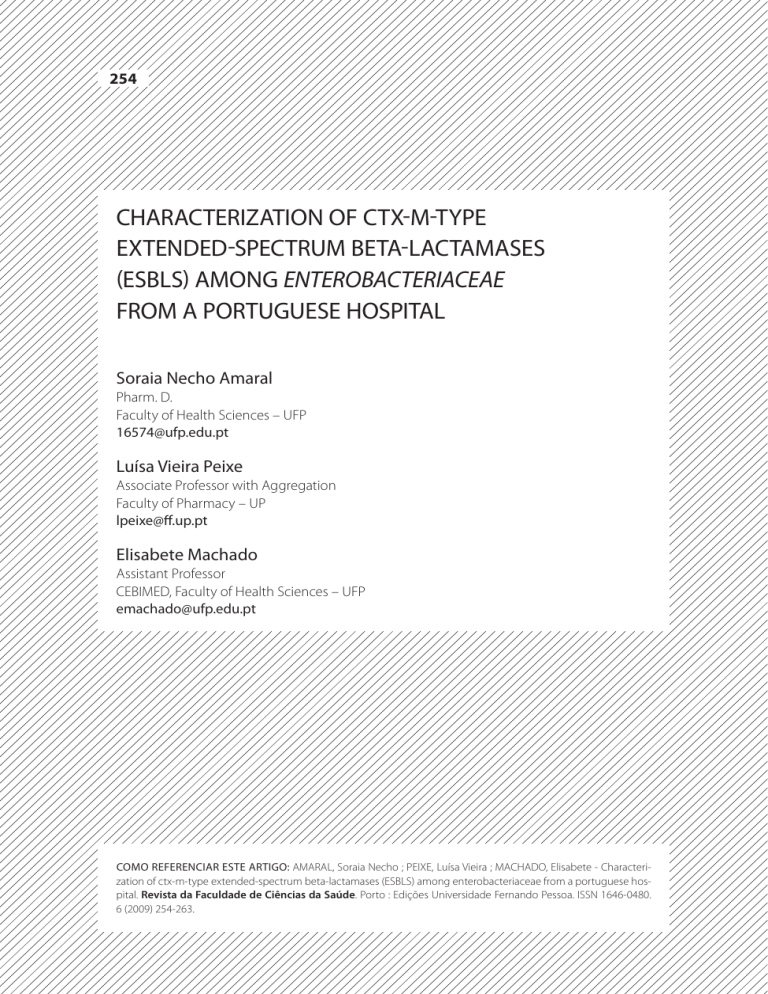
254 Characterization of CTX-M-type Extended-Spectrum Beta-Lactamases (ESBLs) among Enterobacteriaceae from a Portuguese Hospital Soraia Necho Amaral Pharm. D. Faculty of Health Sciences – UFP 16574@ufp.edu.pt Luísa Vieira Peixe Associate Professor with Aggregation Faculty of Pharmacy – UP lpeixe@ff.up.pt Elisabete Machado Assistant Professor CEBIMED, Faculty of Health Sciences – UFP emachado@ufp.edu.pt como referenciar este artigo: AMARAL, Soraia Necho ; PEIXE, Luísa Vieira ; MACHADO, Elisabete - Characterization of ctx-m-type extended-spectrum beta-lactamases (ESBLS) among enterobacteriaceae from a portuguese hospital. Revista da Faculdade de Ciências da Saúde. Porto : Edições Universidade Fernando Pessoa. ISSN 1646-0480. 6 (2009) 254-263. 255 Resumo Na última década tem-se assistido à disseminação de enzimas do tipo CTX-M em diversos países, determinando alterações significativas na epidemiologia das beta-lactamases de espectro alargado (BLEA). A monitorização da disseminação de Enterobacteriaceae produtoras de CTX-M em Portugal foi efectuada em isolados clínicos recentes de um hospital Português. blaCTX-M e ISs associadas ao seu ambiente genético foram pesquisados por PCR. A elevada prevalência de variantes de CTX-M do grupo I confirma a mudança na distribuição dos tipos de BLEA em Portugal. Palavras-Chave Beta-lactamases de espectro alargado, ESBLs, CTX-M, Enterobacteriaceae, Portugal Abstract During the last decade CTX-M enzymes have become widespread in several countries, causing a shift in the ESBL epidemiology of specific areas. In order to monitorize the dissemination of CTX-M-producing Enterobacteriaceae in Portugal, we characterized ESBL producers recovered from a Portuguese hospital. blaCTX-M and specific ISs and genes associated with blaCTX-M genetic environment were searched by PCR. Detection of a high occurrence of CTXM cluster I variants confirms a shift in ESBL distribution towards CTX-M enzymes in Portugal. Keywords Extended-Spectrum Beta-Lactamases, ESBLs, CTX-M, Enterobacteriaceae, Portugal 256 1. Introduction Beta-lactam antibiotics are first-line therapeutic option to treat infections caused by Enterobacteriaceae, but resistance to these compounds has been increasingly reported in the last decades (Rossolini and Mantengoli, 2008). Different mechanisms of resistance to this antibiotic family have been described and include porin alterations, Penicillin Binding Proteins (PBPs) modifications, efflux systems and/or production of enzymes capable of beta-lactams hydrolysis (beta-lactamases) (Bradford, 2001). In Enterobacteriaceae, production of ExtendedSpectrum Beta-Lactamases (ESBLs) constitutes the most common resistance mechanism to beta-lactam antibiotics (Rossolini and Mantengoli, 2008). ESBL enzymes have hydrolytic capacities over several beta-lactams, including penicillins, monobactams and extended-spectrum cephalosporins (except cephamycins), and are inactivated by classic beta-lactamase inhibitors such as clavulanic acid (Gniadkowski, 2001). Only carbapenems (e.g. imipenem) are stable to these enzymes, constituting the unique therapeutical option in the group of the beta-lactams (Gniadkowski, 2001). ESBL-producing bacteria are also frequently resistant to non-beta-lactam antibiotics, as genes encoding to these patterns are also frequently located in the same mobile genetic platform (plasmid, transposon and/or integron) carrying blaESBL genes (Cantón et al., 2008; Paterson and Bonomo, 2005). This situation makes more difficult the therapy of some infections caused by ESBL-producing organisms. Since the first report of an ESBL-producing Klebsiella pneumoniae in 1983 in Germany, several nosocomial outbreaks of ESBL-producing organisms have been described worldwide (Cantón et al., 2008). Prevalence of ESBLs is high in nosocomial environments mainly because of long-term exposure to antibiotics and catheterization, among other factors (Bradford, 2001). However, spread of ESBLs has also been demonstrated in other ecological niches such as healthy humans, animals, and aquatic environments (Bradford, 2001; Carattoli, 2008; Machado et al., 2004; Machado et al., 2008; Machado et al., 2009). Several ESBL types have been created, according to their amino acid sequences, and their hydrolytic ability over several beta-lactam antibiotics (Bradford, 2001; http://www.lahey.org/ studies/webt.htm). TEM and SHV families have evolved from TEM-1, TEM-2, or SHV-1 enzymes, respectively, by stepwise mutations that affect the active site of the enzyme extending its spectrum of activity (Bradford, 2001), and have been traditionally considered the most widespread ESBLs (Bradford, 2001; Cantón et al., 2008; Gniadkowski, 2001). They are mainly found among Enterobacteriaceae, although recent reports describe their presence among non-Enterobacteriaceae species (e.g. Pseudomonas aeruginosa) (Bradford, 2001). Non-TEM/SHV-type ESBLs, include CTX-M, OXA, GES, IBC, VEB, PER and other variants, and until recently these enzymes were rarely reported (Bradford, 2001). During the last decade CTX-M enzymes have become widespread in several countries, causing a shift in the ESBL epidemiology of specific areas (Cantón and Coque, 2006; Hawkey, 2008; Livermore et al., 2007; Walther-Rasmussen and Hoiby, 2004). In Europe, CTX-M enzymes are becoming the predominant ESBLs, as stated recently by Euro Surveillance (Coque et al., 2008). These enzymes were firstly designated as CefoTaXiMases (CTX-M) due to their higher hydrolytic activity over cefotaxime than ceftazidime (Walther-Rasmussen and Hoiby, 2004). However, CTX-M enzymes able to efficiently hydrolyze ceftazidime have also been described (Bonnet, 2004). These enzymes are grouped in five clusters (CTX-M-1, CTX-M-2, CTX-M-8, CTX-M-9 and CTX-M-25) on the basis of their amino acid sequences (Figure 1) (Bonnet, 2004). Chromosomal beta-lactamase genes from some Kluyvera species (widely dis- tributed in the environment) have been suggested as the ancestors of each CTX-M-cluster and mobilization of blaCTX-M genes to other bacterial genera seems to have occurred through recombinatorial events mediated by ISCR1, ISEcp1 or phage related elements (Bonnet, 2004; Lartigue et al., 2004; Oliver et al., 2001; Tolemman et al., 2006). CTX-M enzymes remain mainly detected in Escherichia coli, Klebsiella pneumoniae, and Salmonella enterica serovar Typhimurium (Bonnet, 2004; Bradford, 2001), but they were also recently identified in Vibrio cholerae, Acinetobacter baumannii or Aeromonas hydrophila (Walther-Rasmussen and Hoiby, 2004). Figure 1. Phylogenetic tree for CTX-M enzymes (adapted from Lahey Clinic) (http://www.lahey.org/studies/webt.htm) The rapid and wide spread of CTX-M enzymes worldwide is mainly due to the frequent association of blaCTX-M genes with genetic mobile elements, such as epidemic plasmids, transposons, and/or insertion sequences located upstream blaCTX-M also responsible for the expression of gene (e.g. blaCTX-M-15) (Cantón and Coque, 2006; Coque et al., 2008; Lartigue et al., 2004). However, CTX-M epidemiology is much more complex, involving not only horizontal gene transfer, but also the clonal dissemination of CTX-M-producing organisms (e.g. CTX-M-15-producing epidemic clones) (Cantón and Coque, 2006; Cantón et al., 2008). All of these factors contribute to the increasing dissemination of CTX-M ESBLs in nosocomial and community environments (Cantón and Coque, 2006), placing CTX-M-producing organisms as a serious clinical issue. 257 258 Overall, CTX-M-15 is achieving great dominance in Europe (Cantón and Coque, 2006; Coque et al., 2008) and in a previous survey (2003-2005) performed in tertiary care Portuguese hospitals dissemination of epidemic strains and plasmids coding for CTX-M-15 enzymes were also reported (Machado et al., 2007). Shifts in ESBL-epidemiology might impose new therapeutic and infection control approaches, justifying their periodic surveillance, and hence a continuous surveillance in a bigger scale, comprising hospitals from diverse geographic areas is imperative (Coque et al., 2008). In this way, the objectives of the present study were to characterize and analyse the diversity the CTX-M ESBLs among Enterobacteriaceae from a Portuguese hospital not previously evaluated, over a period of nine months, in order to gather useful epidemiological data that might contribute to the design of interventions to control the dissemination of CTX-M-producing organisms and/or CTX-M enzymes in our country. 2. Materials and methods 2.1. Bacterial isolates A total of sixteen Enterobacteriaceae isolates recovered at Hospital A from the Centre region of Portugal and previously identified as presumptive ESBL producers were included in the present work. The isolates were obtained from clinical samples recovered from patients at several hospital wards between May 2007 and January 2008. Species identification, preliminary susceptibility testing and presumptive detection of ESBL production were performed at the hospital using the Vitek Automatic System (bioMérieux, Marcy-l’Étoile, France). 2.2. Antimicrobial susceptibility testing Further antibiotic susceptibility testing was performed by the disc diffusion method following the CLSI guidelines (CLSI, 2007). Antimicrobial agents tested were the following: amoxicillin/clavulanic acid (30 µg), cefoxitin (30 µg), cefoxatime (30 µg), ceftazidime (30 µg), cefepime (30 µg), aztreonam (30 µg), imipenem (10 µg), ciprofloxacin (5 µg), nalidixic acid (30 µg), gentamicin (10 µg), amikacin (30 µg), tobramycin (10 µg), streptomycin (10 µg), spectinomycin (25 µg), netilmicin (30 µg), kanamycin (30 µg), trimethoprim (5 µg), sulfonamides (300 µg), tetracyclines (30 µg), and chloramphenicol (30 µg). Discs were purchased from OXOID (Basingstoke, England). All intermediate-susceptible isolates were considered as non-susceptible. 2.3. Detection of ESBL producers The presence of an ESBL phenotype was confirmed by the standard double-disc synergy test (DDST), using cefoxatime, ceftazidime, cefepime, and aztreonam discs placed 25 mm apart from an amoxicillin/clavulanic acid disc (Jarlier et al., 1988; Machado et al., 2007). 2.4. Molecular characterization of CTX-M ESBLs and their genetic environment 259 2.4.1. Polymerase Chain Reaction (PCR) amplifications Molecular characterization of CTX-M ESBLs was performed by PCR using genomic DNA from wild type strains. Bacterial DNA was extracted by boiling a bacterial suspension in 300 µL of water during 10 minutes, followed by centrifugation. Amplification of beta-lactamase (bla) genes coding for CTX-M was achieved using primers and amplification conditions for detection of a conserved sequence of blaCTX-M (Edelstein et al., 2003). Further amplification of other regions of the blaCTX-M gene which allow the determination of the CTX-M enzyme cluster and/or type was carried out using another set of primers specific for genetic regions that characterize each CTX-M cluster (Pitout et al., 2004). For selected cases, pairs of primers were designed for sequencing reactions of specific blaCTX-M genes (Machado et al., 2006). Presence of specific ISs and genes associated with blaCTX-M genetic environment were also searched by PCR (ISEcp1, blaOXA, blaTEM) (Bert et al., 2002; Machado et al., 2004; Machado et al., 2007). Primers and conditions used for all amplification reactions are presented in Table 1. Table 1. Primers sequences and PCR conditions used in this study. Primer Sequence ( 5’-3’) CTX-M-F’ TTT GCG ATG TGC AGT ACC AGT AA CTX-M-R’ CGA TAT CGT TGG TGG TGC CAT A CTXM1-F3 GAC GAT GTC ACT GGC TGA GC CTXM1 R2 AGC CGC CGA CGC TAA TAC A TOHO1-2F GCG ACC TGG TTA ACT ACA ATC C TOHO1-1R CGG TAG TAT TGC CCT TAA GCC CTXM825-F CGC TTT GCC ATG TGC AGC ACC CTXM825-R GCT CAG TAC GAT CGA GCC CTXM914-F GCT GGA GAA AAG CAG CGG AG CTXM914-R GTA AGC TGA CGC AAC GTC TG CTX-M 10F deg ATG GTT AAA AAA TCA CTG CGT C CTX-M 10R deg TTA CAA ACC GTY GGT GAC G TEM-F ATG AGT ATT CAA CAT TTC CG TEM-R CTG ACA GTT ACC AAT GCT TA OXA-Group III-F TTT TCT GTT GTT TGG GTT TT OXA-Group III-R TTT CTT GGC TTT TAT GCT TG ISEcp1-F ATC TAA CAT CAA ATG CAG G ISEcp1-R AGA CTG CTT CTC ACA CAT Gene Size (bp) Amplification Conditions CTX-M 590 1 cycle of 10 min at 94ºC; 35 cycles of 1 min at 94 ºC, 1 min at 51ºC, 1 min at 72ºC; 1 cycle of 10 min at 72 ºC [MgCl2] Reference 1.7 Edelstein et al., 2003 CTX-M Cluster I 499 1 cycle of 10 min at 94ºC; 35 cycles of 1 min at 94 ºC, 1 min at 55ºC, 1 min at 72ºC; 1 cycle of 10 min at 72 ºC 1.7 Pitout et al., 2004 CTX-M Cluster II 351 1 cycle of 10 min at 94ºC; 35 cycles of 1 min at 94 ºC, 1 min at 55ºC, 1 min at 72ºC; 1 cycle of 10 min at 72 ºC 1.7 Pitout et al., 2004 CTX-M Cluster III 307 1 cycle of 10 min at 94ºC; 35 cycles of 1 min at 94 ºC, 1 min at 55ºC, 1 min at 72ºC; 1 cycle of 10 min at 72 ºC 1.7 Pitout et al., 2004 CTX-M Cluster IV 474 1 cycle of 10 min at 94 ºC; 35 cycles of 1 min at 94 ºC, 1 min at 62 ºC, 1 min at 72 ºC; 1 cycle of 10 min at 72 ºC 1.7 Pitout et al., 2004 CTX-M (sequencing) 876 1 cycle of 10 min at 94 ºC; 35 cycles of 1 min at 94ºC, 1 min at 55,5 ºC, 1 min at 72 ºC; 1 cycle of 10 min at 72ºC 1.7 Machado et al., 2006 TEM 847 1 cycle of 10 min at 94 ºC; 35 cycles of 1 min at 94 ºC, 1 min at 58 ºC, 1 min at 72 ºC; 1 cycle of 10 min at 72 ºC 1.7 Machado et al., 2007 OXA 427 1 cycle of 10 min at 94 ºC; 35 cycles of 1 min at 94ºC, 1 min at 54 ºC, 1 min at 72 ºC; 1 cycle of 10 min at 72ºC 1.2 Bert et al., 2002 ISEcp1 1391 1 cycle of 10 min at 94 ºC; 35 cycles of 1 min at 94ºC, 1 min at 59 ºC, 5 min at 72 ºC; 1 cycle of 10 min at 72ºC 1.5 Machado et al., 2004 2.4.2. Visualization of PCR results After amplification reactions, PCR products were analysed in 2% agarose gels, using the following electrophoresis conditions: 100 V, 35 minutes, TAE buffer 1X. SYBR SafeTM DNA Gel Stain (Invitrogen, Paisly, United Kingdom) at 0.1 µL/mL was used as a nucleic acid intercalator for detection of the amplified products under an UV light. 260 2.4.3. Purification of PCR Products Selected PCR products were purified using the Wizard® SV Gel and PCR Clean-UP System (PROMEGA Corporation, USA) following the manufacturer instructions. 2.4.4. Sequencing Sequencing reactions of purified PCR products were performed using the ABI 3700 automated sequencer (Applied Biosystems, Perkin-Elmer, Foster City, CA). Nucleotide sequences were compared to sequences in the GenBank and EMBL databases by using the BLASTN local alignment search tools. Protein sequences derived from the genes were aligned using CLUSTAWL and analysed in order to identify the CTX-M-type according to sequences published in http://www.lahey.org/studies/webt.htm. 3. Results and discussion Presence of CTX-M ESBLs was observed in twelve isolates (75%, 12/16) identified as E. coli (n=8), K. pneumoniae (n=1), P. mirabilis (n=2), and E. cloacae (n=1) (Table 2). The CTX-M-producing isolates were obtained from clinical samples of patients located at the following hospital wards: Medicine I (n=5), General Urgency (n=2), Medicine II (n=2), Men Medicine (n=1), Orthopedy (n=1), and Gastroenterology (n=1). These isolates were recovered from urine (n=10), pus (post-surgery) (n=1), and exsudates (n=1). Most of the CTX-M-producing isolates exhibited non-susceptibility profiles to several non-beta-lactam antibiotics (Table 2). E. coli was the species most frequently found as ESBL producer (56%, 9/16), which is in accordance with reports from other authors (Cantón et al., 2008). CTX-M-producing E. coli showed a clear spread among different wards of the studied hospital, being more prevalent in Medicine I ward (Table 2). Table 2. Characterization of CTX-M-producing Enterobacteriaceae isolates included in this study. Isolate Species Date of isolation Origin Specimen (mo/day/yr) Ward Βeta-Lactamases (detected and/or sequenced bla genes ) ISEcp1 Non-β-lactam resistance phenotype a Tb, Cp, Na, Te, Km H559 E. coli 5/13/07 Hospital A Urine General Urgency OXA, CTX-M cluster I + H560 E. coli 6/30/07 Hospital A Urine Medicine I TEM, OXA, CTX-M cluster I + Tb, Cp, Na, Km H567 E. coli 5/30/07 Hospital A Urine Medicine I TEM, CTX-M cluster I + Gm, Tb, Cp, Na, Te, Nt, Km 1/4/08 Men Medicine TEM-1*, OXA, CTX-M-15-variant* + H580 E. coli Hospital A Urine H588 E. coli 11/29/07 Hospital A Urine General Urgency TEM, OXA, CTX-M cluster I H596 E. coli 12/29/07 Hospital A Urine Medicine I OXA, CTX-M cluster I H602 E. coli H607 E. coli H565 + Gm, Tb, Ak, Sm, Sp, Cp, Na, Te, Nt, Km Gm, Tb, Ak, Sm, Cp, Na, Te, Nt, Km + Gm, Tb, Sm, Sp, Cp, Na, Su, Te, Cm, Nt, Km Hospital A Urine Orthopedy TEM, CTX-M cluster III, CTX-M-1* + Gm, Tb, Sm, Sp, Na, Su, Tp, Te, Nt, Km 12/19/07 Hospital A Urine Gastroenterology TEM, OXA, CTX-M cluster I + Gm, Tb, Sm, Cp, Na, Te, Nt, Km K. pneumoniae 5/24/07 Hospital A Urine Medicine I CTX-M cluster I – Sm, Sp, Cp, Na, Su, Tp, Te, Cm 1/8/08 H585 P. mirabilis Pus 12/2/07 Hospital A (surgery) Medicine II OXA, CTX-M-15-variant* – Gm, Tb, Ak, Sm, Sp, Cp, Na, Tp, Te, Nt, Km H627 P. mirabilis 12/29/07 Hospital A Exsudate Medicine II TEM, OXA, CTX-M cluster I + Gm, Tb, Ak, Sm, Sp, Cp, Na, Te, Nt, Km H605 E. cloacae 11/29/07 Hospital A Medicine I TEM, OXA, CTX-M cluster I + Gm, Tb, Ak, Sm, Cp, Na, Te, Nt, Km Urine Tb, tobramycin; Ak, amikacin; Sm, streptomycin; Nt, netilmicin; Km, kanamycin; Su, sulphonamides; Tp, trimethoprim, Te, tetracycline; Cp, ciprofloxacin; Na, nalidixic acid; Cm, chloramphenicol; Sp, spectinomycin; Gm, gentamicin a Among the CTX-M enzymes, CTX-M belonging to cluster I were the most frequently detected, being identified among all CTX-M-producing isolates (Table 2). CTX-M enzymes of clusters III were only found in one E. coli isolate also harbouring a TEM and a CTX-M enzyme of cluster I. Isolates belonging to CTX-M clusters II or IV were absent. For specific amplified blaCTX-M genes, a detailed characterization of the nucleotide sequence was carried out. Sequencing results revealed two distinct CTX-M-types: CTX-M-1 and CTX-M-15-variants. The presence of CTX-M-15-variants was expected, since the most common CTX-M enzyme in Europe and Portugal has been CTX-M-15. blaTEM and blaOXA genes were commonly found in isolates also harbouring blaCTX-M genes of cluster I (8/12 and 9/12, respectively) (Table 2). These genes have been detected in the same epidemic plasmids carrying the blaCTX-M-15, also associated to the ST131 Complex Type Clone (Coque et al., 2008). The presence of the insertion sequence ISEcp1 was also confirmed in all but one CTX-M producers of cluster I. The CTX-M-15 enzyme was previously found in Portugal (Machado et al., 2006; Mendonça et al., 2007), and the presence of blaTEM and blaOXA in these bacteria could indicate an involvement of the same epidemic plasmid associated to CTX-M-15 enzymes. Concerning CTX-M-1, this enzyme was only found in our country among Enterobacteriaceae recovered from poultry meat or seagulls faeces (Machado et al., 2008; Poeta et al., 2008). Further studies will be necessary to analyse the potential of horizontal transfer of CTX-M-1 and CTX-M-15 variants, and characterize the plasmid involved, in order to evaluate the presence and/or maintenance of epidemic plasmids carrying these CTX-M ESBLs in our country. 4. Conclusions We described a high occurrence of CTX-M enzymes among ESBL-producing Enterobacteriaceae from a Portuguese hospital. The detection of CTX-M-15-variants- and CTX-M1-producing organisms confirms a shift in ESBL distribution towards CTX-M enzymes, a finding previously observed in other regions of our country and in Europe (Coque et al., 2008; Machado et al., 2007). The twelve CTX-M-producing Enterobacteriaceae in a total of eighty Enterobacteriaceae that were recovered during the analysis period, can be considered a devastating threat to public health, as plasmidic and/or clonal dissemination might be present and would amplify the level of danger to the community. Further analysis will better highlight the current epidemiology of CTX-M-producing Enterobacteriaceae in this hospital. The present epidemiological information will be useful in the design of interventions to control the dissemination of CTX-M-producing organisms and/or CTX-Ms in this hospital and, ultimately, in our country. 5. Acknowledgements We are very grateful to Dr. Ricardo Silva (Laboratório de Microbiologia, Faculdade de Ciências da Saúde – Universidade Fernando Pessoa) for all technical support. 261 262 References Bert, F.; Branger, C.; Lambert-Zechovsky, N. (2002). Identification of PSE and OXA beta-lactamase genes in Pseudomonas aeruginosa using PCR-restriction fragment length polymorphism. In: Journal of Antimicrobial Chemotherapy, 50,11-8. Bonnet, R. (2004). Growing group of extended-spectrum beta-lactamases: the CTX-M enzymes. In: Antimicrobial Agents and Chemotherapy, 48, 1-14. Bradford, P. (2001). Extended-spectrum β-lactamases in the 21st century: characterization, epidemiology, and detection of this important resistance threat. In: Clinical Microbiology Reviews, 14, 933-51. Cantón, R.; Coque, T.M. (2006). The CTX-M beta-lactamase pandemic. In: Current Opinion in Microbiology, 9, 466-75. Cantón, R.; Novais, A.; Valverde, A.; Machado, E.; Peixe, L.; Baquero, F.; Coque, T.M. (2008). Prevalence and spread of extended-spectrum beta-lactamase-producing Enterobacteriaceae in Europe. In: Clinical Microbiology and Infection,14, 144-53. Carattoli, A. (2008). Animal reservoirs for extended-spectrum beta-lactamase producers. In: Clinical Microbiology and Infection, 14, 117-23. Clinical and Laboratory Standards Institute. (2007). Performance standards for antimicrobial susceptibility testing, 17th. Approved standard M100-S17. Clinical and Laboratory Standards Institute, CLSI, Wayne, Pa. Coque, T.M.; Baquero, F.; Cantón, R. (2008). Increasing prevalence of ESBL-producing Enterobacteriaceae in Europe. In: Euro surveillance,13, Issue 47, 20 November, 19044. Edelstein, M.; Pimkin, M.; Palagin, I.; Edelstein, I. and Stratchounski, L. (2003). Prevalence and molecular epidemiology of CTX-M extended-spectrum β-lactamaseproducing E. coli and K. pneumoniae in Russian hospitals. In: Antimicrobial Agents and Chemotherapy, 47, 3724-32. Gniadkowski, M. (2001). Evolution and epidemiology of extended-spectrum beta-lactamases (ESBLs) and ESBL-producing microorganisms. In: Clinical Microbiology and Infection,7, 597-608. Hawkey, PM. (2008). Prevalence and clonality of extended-spectrum beta-lactamases in Asia. In: Clinical Microbiology and Infection, 14, 159-65. Jarlier, V.; Nicolas, M.; Fournier, G.; Philippon, A. (1988). Extended broad-spectrum beta-lactamases conferring transferable resistance to newer β-lactams agents in Enterobacteriaceae: hospital prevalence and susceptibility patterns. In: Reviews of Infectious Disesases,10, 867-78. Lartigue, M.F.; Pirel, L.; Nordmann, P. (2004). Diversity of genetic environment of bla(CTX-M) genes. In: FEMS Microbiology Letters, 234, 201-7. Livermore, D.M.; Cantón, R.; Gniadkowski, M.; Nordmann, P.; Rossolini, G.M.; Arlet, G.; Ayala, J.; Coque, T.M.; Kern-Zdanowicz, I.; Luzzaro, F.; Poirel, L.; Woodford, N. (2007). CTX-M: changing the face of ESBLs in Europe. In: Journal of Antimicrobial Chemotherapy, 59, 165-74. Machado, E.; Coque, T.M.; Cantón, R.; Sousa,J.C. and Peixe, L. (2004). Emergence of CTX-M beta-lactamase producing Enterobacteriaceae in Portugal: report of an Escherichia coli isolate harbouring blaCTX-M-14. In: Clinical Microbiology and Infection, 10, 755-7. Machado, E.; Coque, T.M.; Cantón, R; Baquero, F.; Sousa, J.C.; Peixe, L.; Portuguese Resistance Study Group. (2006). Dissemination in Portugal of CTX-M-15-, OXA-1-, and TEM-1-producing Enterobacteriaceae strains containing the aac(6’)-Ib-cr gene, which encondes an aminoglycoside- and fluoroquinolone-modifying enzyme. In: Antimicrobial Agents and Chemotherapy, 50, 3220-1. Machado, E.; Coque, T.M.; Cantón R.; Novais A.; Sousa, J.C.; Baquero, F. and Peixe, L., on behalf of The Portuguese resistance Study Group. (2007). High diversity of extended-spectrum beta-lactamases among clinical isolates of Enterobacteriaceae from Portugal. In: Journal of Antimicrobial Chemotherapy, 60, 1370-4. Machado, E.; Coque, T.M.; Cantón, R.; Sousa, J.C. and Peixe, L. (2008). Antibiotic resistance integrons and extended-spectrum beta-lactamases among Enterobacteriaceae isolates recovered from chickens and swine in Portugal. In: Journal of Antimicrobial Chemotherapy, 62, 296-302. Machado, E.; Coque, T.M.; Cantón, R.; Sousa, J.C.; Silva, D.; Ramos, M.; Rocha, J.; Ferreira, H. and Peixe, L. (2009). Leakage into Portuguese aquatic environments of extended-spectrum-beta-lactamase-producing Enterobacteriaceae. In: Journal of Antimicrobial Chemotherapy, 63, 616-8. Mendonça, N.; Leitão, J.; Manageiro, V.; Ferreira, E.; Caniça, M. (2007). Spread of extended-spectrum beta-lactamase CTX-M-producing Escherichia coli clinical isolates in community and nosocomial environments in Portugal. In: Antimicrobial Agents and Chemotherapy 51, 1946-55. Oliver, A.; Perez-Díaz, J.C.; Coque, T.M.; Baquero, F; Cantón, R. (2001) Nucleotide sequence and characterization of a novel cefotaxime-hydrolysing beta-lactamase (CTXM-10) isolated in Spain. In: Antimicrobial Agents and Chemotherapy, 45, 616-20. Paterson, D.L.; Bonomo, R.A. (2005). Extended-spectrum beta-lactamases: a clinical update. In: Clinical Microbiology Reviews, 18, 657-86. Pitout, J.D.; Hossain, A. and Hanson N.D. (2004). Phenotypic and molecular detection of CTX-M-beta-lactamases produced by Escherichia coli and Klebsiella spp. In: Journal of Clinical Microbiology, 42, 5715-21. Poeta, P.; Radhouani, H.; Igrejas, G.; Gonçalves, A.; Carvalho, C.; Rodrigues, J.; Vinué, L.; Somalo, S.; Torres, C. (2008). Seagulls of the Berlengas natural reserve of Portugal as carriers of fecal Escherichia coli harboring CTX-M and TEM extended-spectrum beta-lactamases. In: Applied and Environmental Microbiology, 74, 7439-41. Rossolini, G.M.; Mantengoli, E. (2008). Antimicrobial resistance in Europe and its potencial impact on empirical therapy. In: Clinical Microbiology and Infection, 14, 33-41. Toleman, M.A.; Bennet, P.M.; Walsh, T.R. (2006). ISCR elements: novel gene-capturing systems of the 21st century? In: Microbiology and Molecular Biology Reviews, 70, 296-316. Walther-Rasmussen, J.; Hoiby, N. (2004). Cefotaximases (CTX-M-ases), an expanding family of extended-spectrum beta-lactamases. In: Canadian Journal of Microbiology, 50, 137-65. 263
